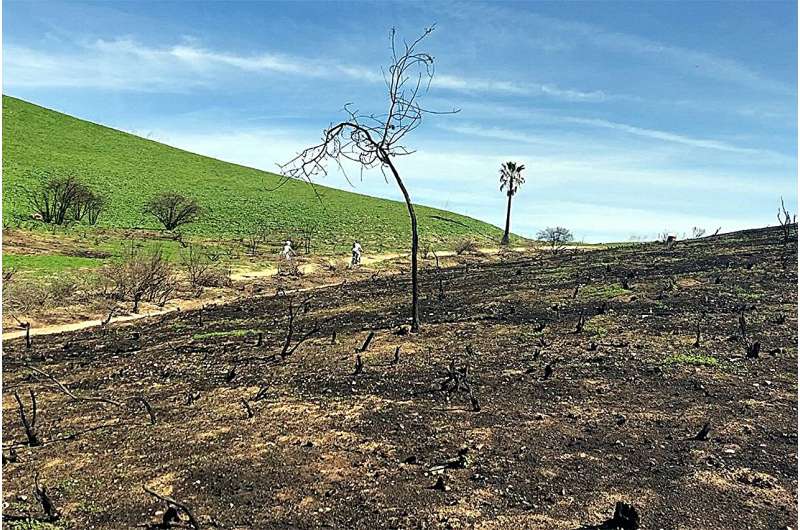This article has been reviewed according to Science X's editorial process and policies. Editors have highlighted the following attributes while ensuring the content's credibility:
fact-checked
peer-reviewed publication
trusted source
proofread
'This is about hope': Scientists offer climate solutions for sustainability in California

Climate change is already here, and a diverse group of scientists have solutions for California.
Calling for hope and adaptations, they review the state of sustainability in California in this week's special issue of the Proceedings of the National Academy of Sciences. Led by UCLA professor Glen MacDonald and San Diego State University professor Janet Franklin, the researchers connect issues like the affordable housing crisis and increased wildfire damage.
The group of more than 40 government scientists, nongovernmental experts and university scholars hope to globally apply solutions for the U.S state with the largest population, largest economy and third-largest landmass.
"We have to adapt because climate change is happening now—and it's only going to get worse," said MacDonald, a climate scientist and professor of geography with the UCLA Institute of the Environment and Sustainability.
"But you cannot tell people there's nothing they can do about it, because that's not true. This is about hope. We want people to know there's very serious thought on solutions and mitigations, but we have to start working on them now."
Among the solutions:
- Justice: Center environmental justice, health equity and housing needs to build the diverse coalitions vital to enacting climate policies;
- Indigenous leadership: Fully incorporate Indigenous people and their ecological knowledge in government, in both state environmental policy and in wildfire management;
- Add greenery to cool heat islands: Add more greenery to cities to lower the temperature around heat islands, add shade and reduce heat risks in low-income communities;
- Expand marshlands to protect coasts: Allow for landward expansion of coastal wetlands and marshes—sometimes into agricultural land—to gain protection against sea-level rise, storm surges and saltwater inundation of freshwater ecosystems;
- Denser cities, fewer houses in wildfire zones: Increase firewise planning, such as where to allow development and what materials can be used, to reduce wildfire encroachment on suburban and urban areas and to protect housing.
The authors drew connections between existing sustainability challenges and encroaching climate change challenges. The lack of affordable housing in urban cores forces people to expand into wild areas, increasing the risk of wildfires from human-caused ignitions—the source of most California blazes—while simultaneously bringing housing closer to the wildfire danger zones.
"We have to increase urban density so we are not putting so many people at risk in housing developments in the wildland-urban interface zone," MacDonald said.
While researchers expect climate change to cause increased wildfires in Northern California and the Sierra Nevada, that's not the story everywhere, said Franklin, an SDSU professor of geography.
"There's no one-size-fits-all fire landscape in California," Franklin said. "Our models predicted an increase in fire in Southern California, but not so much directly because of climate change, and actually more driven by the human influence of urban growth."
California has the nation's largest Indigenous population and is the second-most diverse state, the researchers note. By including academic and scientific authors from the Indigenous and underserved communities, the organizers sought to ensure those perspectives were well represented.
"Sustainability is fundamental to equality, and it has to be tackled by taking advantage of the diversity of the state of California," MacDonald said. "We cannot have solutions that work for people in Beverly Hills but do not work for farm laborers working in the Central Valley of California."
Building stronger, more diverse bases of support benefits everyone, said Manuel Pastor, a professor of sociology and of American Studies and Ethnicity at the University of Southern California and lead author of the climate justice paper.
"Incorporating environmental justice into climate policies is not just a moral imperative but a practical necessity," Pastor said. "Our study reveals that policies rooted in equity are more resilient and effective in combating climate change—and critical to building the political coalitions that can save our planet."
A wide-ranging paper on public health and climate change led by UCLA public health professor Michael Jerrett explored the challenges, adaptations and solutions related to wildfire smoke, heat islands, flash floods and more, noting the high number of deaths associated with smoke inhalation, extreme heat and heavy rain in California alone.
Although California is one of the least greenhouse-gas-intensive states in the country, global emissions require a global response, MacDonald said.
"California is trying to be a leader in mitigation and decreasing greenhouse gases, but it cannot do it alone. We have to focus on adaptation until we get to the point that we are able to meaningfully mitigate greenhouse gas emissions," MacDonald said. "Our solutions are a small sampling of some of the solutions that are out there, which means there's lots of things we can do if we start taking this seriously, and we start doing it now."
More information: Manuel Pastor et al, California dreaming: Why environmental justice is integral to the success of climate change policy, Proceedings of the National Academy of Sciences (2024). DOI: 10.1073/pnas.2310073121
Michael Jerrett et al, Climate change and public health in California: A structured review of exposures, vulnerable populations, and adaptation measures, Proceedings of the National Academy of Sciences (2024). DOI: 10.1073/pnas.2310081121
Journal information: Proceedings of the National Academy of Sciences
Provided by University of California, Los Angeles




















